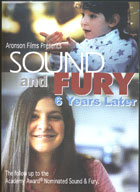
Sound and Fury: 6 Years Later 2006
Distributed by Filmakers Library, 124 East 40th Street, New York, NY 10016; 202-808-4980
Produced by Josh Aronson
Directed by Josh Aronson
DVD, color, 30 min.
College - Adult
Health Sciences, Psychology, Audiology, Parenting, Deaf and Hearing Cultures, Communication
Date Entered: 11/13/2006
Reviewed by Lori Widzinski, Health Sciences Library, University at Buffalo, State University of New YorkThis documentary is a follow-up to the critically acclaimed and Academy Award nominated film Sound & Fury (2001). Producer and director Josh Aronson, has created a touching, honest sequel so seamless it isn’t necessary to have viewed the original film. Sound and Fury: 6 Years Later brings the Artinian family dynamics into focus as deaf parents Nita and Peter struggle with the decision to have their deaf children receive cochlear implants.
Heather Artinian, 9 yrs. old in the original film, wants an implant, but her parents want her to remain wholly part of the deaf culture, signing to communicate. Peter’s parents (Heather’s grandparents) are strongly in favor of the implant but fail to convince Peter and Nita of the value for their children. After moving from Long Island, N.Y. to Maryland to live in a primarily deaf community, Nita suffers a nervous breakdown. With Peter commuting to his job in N.Y. and only returning home on weekends, she feels isolated, alone, and tired. Realizing they need the support and love only their family and friends can provide, they return to New York.
Eventually, Peter changes his mind about the cochlear implants, and all the Artinian children (Heather and her two younger brothers) are fitted. This film finds them 6 years after implants, happy, healthy, and thriving in both the hearing and deaf worlds. The deep fears that Peter and Nita felt in the beginning, of losing their children to the hearing world are proven to be unfounded. They speak to communicate at school and with hearing friends and family; and sign at home with their deaf parents. It has opened a world of opportunities that previously were difficult at best.
The film brings out the real core of the decision to bring implants to the kids—not only to give them more opportunities in life, but to provide that basic of human needs—a close, loving extended family. Nita’s (who also gets an implant) credit to her mother-in-law at the dinner table is incredibly heartwarming, particularly in light of the difficult times they went through in the years preceding Heather’s implant. The dinner table scene at the end of the film is a testament to the love, resiliency, and devotion of parenthood. Of special note is the relationship that is developing between Heather and her grandmother. It is a genuine, soulful relationship, which would be no less loving if Heather remained in the deaf world, yet blossoms more brightly because of the implant. The closing scenes as the credits roll of Heather and her grandmother walking together and talking about family stories is at once touching and profoundly satisfying, visually summing up the film.
Sound and Fury: 6 Years Later stands alone as an exceptional piece of filmmaking. Aronson has created the follow-up at the same outstanding level as the original, and the 30 min. running time makes it very appropriate for classroom use. A bit pricey, but worthwhile for libraries supporting curriculums in social work, speech and hearing, deaf culture and psychology, and parenting. May also be of interest for general health sciences collections and education collections. Highly recommended.